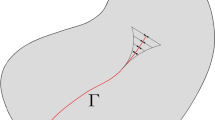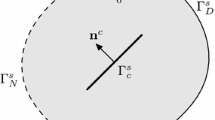Abstract
A variational discrete element method is applied to simulate quasi-static crack propagation. Cracks are considered to propagate between the mesh cells through the mesh facets. The elastic behaviour is parametrized by the continuous mechanical parameters (Young modulus and Poisson ratio). A discrete energetic cracking criterion coupled to a discrete kinking criterion guide the cracking process. Two-dimensional numerical examples are presented to illustrate the robustness and versatility of the method.




















Similar content being viewed by others
References
Ambati M, Gerasimov T, De Lorenzis L (2015) A review on phase-field models of brittle fracture and a new fast hybrid formulation. Comput Mech 55(2):383–405
André D, Girardot J, Hubert C (2019) A novel DEM approach for modeling brittle elastic media based on distinct lattice spring model. Comput Methods Appl Mech Eng 350:100–122
André D, Jebahi M, Iordanoff I, Charles J-L, Néauport J (2013) Using the discrete element method to simulate brittle fracture in the indentation of a silica glass with a blunt indenter. Comput Methods Appl Mech Eng 265:136–147
Arnold D (1982) An interior penalty finite element method with discontinuous elements. SIAM J Numer Anal 19(4):742–760
Belytschko T, Lu YY, Gu L (1994) Element-free Galerkin methods. Int J Numer Methods Eng 37(2):229–256
Borden M, Verhoosel C, Scott M, Hughes T, Landis C (2012) A phase-field description of dynamic brittle fracture. Comput Methods Appl Mech Eng 217:77–95
Bourdin B, Francfort GA, Marigo J-J (2000) Numerical experiments in revisited brittle fracture. J Mech Phys Solids 48(4):797–826
Celigueta MA, Latorre S, Arrufat F, Oñate E (2017) Accurate modelling of the elastic behavior of a continuum with the discrete element method. Comput Mech 60(6):997–1010
Chahine E, Laborde P, Renard Y (2008) Crack tip enrichment in the XFEM using a cutoff function. Int J Numer Methods Eng 75(6):629–646
Dal Maso G (2013) Generalised functions of bounded deformation. J Eur Math Soc 15(5):1943–1997
Di Pietro DA (2012) Cell centered Galerkin methods for diffusive problems. ESAIM M2AN 46(1):111–144
Di Pietro DA, Ern A (2011) Mathematical aspects of discontinuous Galerkin methods, vol 69. Springer, Berlin
Eymard R, Gallouët T, Herbin R (2009) Discretization of heterogeneous and anisotropic diffusion problems on general nonconforming meshes SUSHI: a scheme using stabilization and hybrid interfaces. IMA J Numer Anal 30(4):1009–1043
Francfort GA, Marigo J-J (1998) Revisiting brittle fracture as an energy minimization problem. J Mech Phys Solids 46(8):1319–1342
Hansbo P, Salomonsson K (2015) A discontinuous Galerkin method for cohesive zone modelling. Finite Elem Anal Des 102:1–6
Hildebrandt K, Polthier K, Wardetzky M (2006) On the convergence of metric and geometric properties of polyhedral surfaces. Geom Dedic 123(1):89–112
Hussein A, Hudobivnik B, Aldakheel F, Wriggers P, Guidault P-A, Allix O (2018) A virtual element method for crack propagation. PAMM 18(1):e201800104
Jebahi M, André D, Terreros I, Iordanoff I (2015) Discrete element method to model 3D continuous materials. Wiley, Hoboken
Kuna M (2013) Finite elements in fracture mechanics. Springer, Berlin
Labra C, Oñate E (2009) High-density sphere packing for discrete element method simulations. Commun Numer Methods Eng 25(7):837–849
Li T, Marigo J-J, Guilbaud D, Potapov S (2016) Numerical investigation of dynamic brittle fracture via gradient damage models. Adv Model Simul Eng Sci 3(1):26
Logg A, Mardal K-A, Wells GN et al (2012) Automated solution of differential equations by the finite element method. Springer, Berlin
Marazzato F, Ern A, Monasse L (2020) A variational discrete element method for quasistatic and dynamic elastoplasticity. Int J Numer Methods Eng 121(23):5295–5319
Mariotti C, Michaut V, Molinari J-F (2009) Modeling of the fragmentation by discrete element method. In: DYMAT 2009 9th international conference on mechanical and physical behaviour of materials under dynamic loading. pp 1523–1528
Moës N, Belytschko T (2002) X-FEM, de nouvelles frontières pour les éléments finis. Rev Eur Elém 11(2–4):305–318
Monasse L, Mariotti C (2012) An energy-preserving discrete element method for elastodynamics. ESAIM M2AN 45:1527–1553
Muixí A, Rodríguez-Ferran A, Fernández-Méndez S (2020) A hybridizable discontinuous Galerkin phase-field model for brittle fracture with adaptive refinement. Int J Numer Methods Eng 121(6):1147–1169
Romon P (2013) Introduction à la géométrie différentielle discrète. Ellipses
Sih GC (1974) Strain-energy-density factor applied to mixed mode crack problems. Int J Fract 10(3):305–321
Simon L (1983) Lectures on geometric measure theory. In: Proceedings of the centre for mathematical analysis, vol 3. Australian National University, Australian National University Centre for Mathematical Analysis, Canberra
Spellings M, Marson RL, Anderson JA, Glotzer SC (2017) GPU accelerated discrete element method (DEM) molecular dynamics for conservative, faceted particle simulations. J Comput Phys 334:460–467
Sukumar N, Moran B, Black T, Belytschko T (1997) An element-free Galerkin method for three-dimensional fracture mechanics. Comput Mech 20(1–2):170–175
Zárate F, Cornejo A, Oñate E (2018) A three-dimensional FEM–DEM technique for predicting the evolution of fracture in geomaterials and concrete. Comput Part Mech 5(3):411–420
Zárate F, Oñate E (2015) A simple FEM–DEM technique for fracture prediction in materials and structures. Comput Part Mech 2(3):301–314
Acknowledgements
Partial support by CEA is gratefully acknowledged.
Author information
Authors and Affiliations
Corresponding author
Additional information
Publisher's Note
Springer Nature remains neutral with regard to jurisdictional claims in published maps and institutional affiliations.
Rights and permissions
About this article
Cite this article
Marazzato, F., Ern, A. & Monasse, L. Quasi-static crack propagation with a Griffith criterion using a variational discrete element method. Comput Mech 69, 527–539 (2022). https://doi.org/10.1007/s00466-021-02102-5
Received:
Accepted:
Published:
Issue Date:
DOI: https://doi.org/10.1007/s00466-021-02102-5




